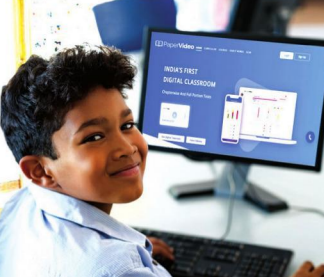Almost every aspect of life has been altered by technology and it appears that educational systems are no exception. Instructors are utilizing current tools and embracing new technology to assist students in achieving their greatest potential. The technology significantly impacts educators, teachers, and students in the current environment.
They use it to collect knowledge or concepts that they can employ daily. During the pandemic, the education system turned to online courses and e-learning platforms to establish a virtual learning environment. Online teachings differ significantly from traditional classroom teachings. Learning becomes more collaborative and exciting as students interact directly with teachers and their peers in a classroom setting. Most educators concur that a high-quality learning experience depends heavily on student’s participation. Interaction, teamwork, and learning activities between students and teachers are simply high in a classroom setting.
Advertisement
Both professors and students are still getting used to the online learning approach; therefore, they are having trouble collaborating online. Teachers must establish a stimulating learning environment to guarantee that students don’t procrastinate their homework and maintain connections with their peers and teachers.
This will prevent distractions for students and ensure quality learning online. Here’s a look at 5 ways that will ensure quality learning:- Give students authority over their learning process to empower them: While studying online, many students experience loneliness and a lack of motivation. Making students feel valued and putting them at the center of the learning process is one of the finest methods to combat this.
Allowing students to select their own tasks allows teachers to create a flexible learning environment. As a result, students will be able to explore topics in-depth and gain new skills. Gamify with rewards:
Online teaching can use gamification features in various ways. It is not required to have fully game-based learning; simple gamification components can offer great potential for enhancing the teaching-learning process. Teachers should appreciate students’ successes by giving them badges, points, or stars. By rewarding top achievers, quick learners, quick problem solvers, etc, they can appreciate each big step a child takes. Speak and repeat: Many students find it challenging to make adjustments to listening comprehension.
Repetition is a wonderful technique to ensure students comprehend the lesson and support the learning process. Teachers must ask for a repetition of the conversations with their students. It’s time well spent, so there is nothing to be worried about if the repetition takes some tutoring time. Establish and follow the rules: A particular online environment can gain flexibility. To prevent distractions, it is a good idea to establish some rules. Teachers can create their own place of teaching and be available to the students at the designated time at all times.
Since online tutoring is a two-way process, it is essential to ensure that communication is simple and that educators are aware of the various academic needs of each student. Same tutor face-to-face: This one applies to tutors who meet with students in person. In order to preserve the continuity of service, the online sessions should ideally be led by an in-person tutor.
The transition to the online tutoring session will be easier with familiarity. Make learning interactive: One of the finest ways to get students interested in a specific topic is to make online lectures interactive. Teachers should motivate students to study in small groups by setting up online groups.
This will facilitate peer interaction and bonding. Furthermore, by integrating online guest lectures from subjectmatter experts, teaching-learning can be made engaging and interesting. Hence, students will become more excited and enthusiastic. Track progress:There are various types of assessments in the virtual classroom. Whether you choose group projects or homework, make the time to develop strategies that track students’ development.
This information can be both inspiring for the students and satisfying for the tutors as well. Show and tell: While teachers surely need to innovate and find ways to enhance the learning process for students, they also need to monitor their progress on a regular basis. No matter how informative their classes are, it would still be redundant unless implemented by students. In the virtual space, the need to monitor the progress of pupils is imperative.
Without in-person supervision, teachers can resort to shared workspaces like Google Drive to exchange notes and monitor assignments to track progress of the students. On the other hand, virtual whiteboards can also enable educators to save their online sessions, which can be accessed by students whenever they need. Introduce self-assessment opportunities: Students may be unable to participate effectively if they cannot track their progress. One of the best ways to enable students to examine their own conceptual comprehension is through selfassessments.
Short examinations, survey questions, and situationbased questions can all be provided by teachers so that students can assess their strengths and limitations. In order to improve their weak areas, students should be encouraged to create a self-learning plan using various e-learning platforms and under their teacher’s supervision. Final Thoughts! For many tutors, the market for online tutoring is expanding, and it provides students many facilities who can’t travel to a physical classroom setting with better convenience.
Even if online learning is becoming the new norm, it is crucial to incorporate effective methodology to achieve the ideal balance and maximize student engagement. Teachers and other educators can use the aforementioned strategies to develop a learning environment that encourages greater student engagement and long-term academic success, which will ensure quality learning











